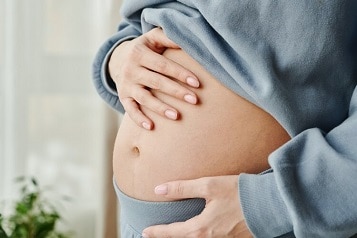
If you deal with severe menstrual pain or are navigating unexplained infertility, you’ve likely heard of endometriosis. Endometriosis is a very common condition—especially among patients with unexplained infertility. ICRM’s Dr. Kyle Tobler explains that nearly “40% of our unexplained infertility patients have endometriosis.”
Treating endometriosis and treating endometriosis related infertility do not always go hand in hand, which can make treatment choices particularly confusing. However, while sometimes complex, it is very much possible to both treat endometriosis symptoms and achieve a successful pregnancy in the face of endometriosis.
What Is Endometriosis?
Endometriosis is a reproductive condition that occurs when the endometrial tissue that lines the inside of the uterus (also called the endometrium) grows outside of the uterus, causing scarring, inflammation, and often severe pain. Most commonly, endometrial tissue grows within the pelvic cavity, which includes the:
- Uterus
- Ovaries
- Fallopian tubes
- Bladder
- Part of the bowel
All of these organs are separate and must be able to move and function independently. When endometrial tissue grows on or in the spaces around these organs, it causes them to stick together, preventing their movement, causing pain, and contributing to infertility.
In more severe cases, endometrial tissue can grow outside of the pelvis as well, in areas like the abdomen, chest cavity, and in rare cases, even the brain.
What Is Endometriosis with Cysts?
Also in more severe cases, fluid-filled cysts, called endometriomas, and sometimes referred to as “chocolate cysts,” can form deep within the ovaries. This type of endometriosis is called deep ovarian endometriosis.
What Are Some Endometriosis Signs?
The symptoms of endometriosis can vary significantly from person to person. Some patients even experience silent, or asymptomatic endometriosis, which is one reason it is often the culprit of unexplained infertility.
For those without symptoms, one sign of endometriosis is premenstrual spotting, or bleeding between menstrual periods. Because it suggests that the uterine lining is not getting enough support, this is often a sign of infertility. More often than not, an infertility patient with suspected endometriosis has premenstrual spotting.
For those with symptomatic endometriosis, the most common symptoms include:
- Very painful menstrual cramps
- Heavy menstrual bleeding
- Chronic pain in the lower back and pelvis
- Uterine pain during or after intercourse
- Intestinal pain
- Pain when urination during menstrual periods.
- Digestive problems like diarrhea, constipation, bloating, or nausea, especially during menstrual periods
Does Endometriosis Cause Infertility?
Endometriosis can cause infertility, but it does not always. Approximately 30–50% of people with endometriosis experience infertility.
Endometriosis can cause infertility in a couple of different ways. The most common cause is inflammation. Endometrial tissue can grow around the ovaries, on the fallopian tubes, or most commonly, in the posterior cul-de-sac, causing inflammation that can inhibit the fertilization process or damage the eggs during fertilization. Endometriosis can also cause hormonal imbalances and scar tissue that contribute to infertility.
How Is Endometriosis Diagnosed?
Endometriosis can be suspected through symptom reports, MRI scans, and ultrasounds, but the only way to definitively diagnose endometriosis is through a laparoscopy. This minimally invasive surgical procedure involves an abdominal incision and insertion of a small camera with which endometrial tissue can be seen and biopsied.
Laparoscopies are most common among patients treating endometriosis symptoms through surgical removal. For patients who are primarily treating infertility, this diagnostic process is usually unnecessary, as treating endometriosis suspected infertility is typically the same as treating infertility with confirmed endometriosis.
The only way in which a laparoscopic diagnosis might affect infertility treatment is by revealing severe damage to the reproductive organs that would indicate a low chance of success with less invasive attempts and require more aggressive first-line treatments.
Treating Endometriosis
Because some treatments for endometriosis are not compatible with fertility, treating endometriosis can look a number of different ways depending on whether the patient’s primary goal is to alleviate symptoms or to have a baby.
The most common methods for treating endometriosis symptoms are hormone treatment and surgical removal, while the most common methods for treating endometriosis related infertility are ovulation induction and in vitro fertilization (IVF).
Treating Endometriosis Symptoms
For some women, managing the symptoms of endometriosis is the first priority. This can be achieved through basic pain relievers (in some mild cases), hormone treatment, or surgery.
Hormone Treatment
The most common hormone for treating endometriosis is progesterone in the form of birth control pills. The menstrual cycle activates the thickening and shedding of the endometrium, and for people with endometriosis, it also activates the growth of endometrial deposits outside of the uterus.
By regulating the menstrual cycle with progesterone, you can suppress this menstrual activity and consequently reduce endometriosis growth and symptoms. While this treatment is not compatible with pregnancy, no long-term harm to fertility has been associated with it, so it can be continued up until you are ready to get pregnant.
Laparoscopic Surgery
Laparoscopic surgery is used to remove endometrial tissue and scar tissue. This can provide long-term relief of symptoms, but it is important to note that surgery can result in scar tissue which can harm fertility. As a result, surgery is generally reserved for cases in which other treatments have been unsuccessful.
Because pregnancy itself can suppress endometriosis, it is often recommended that women with endometriosis who want to have children try to get pregnant first. Periods are halted during pregnancy, so endometrial deposits do not cycle and can even go dormant. Additionally, the increased levels of progesterone during pregnancy can suppress endometrial growth. This often relieves pain and reduces the need for other treatments.
Pregnancy with Endometriosis
Can You Get Pregnant with Endometriosis?
Achieving fertility with endometriosis is very much possible. In fact, the majority of women with endometriosis have no trouble becoming pregnant. Those who do face infertility are usually able to become pregnant by treating endometriosis related issues. Additionally, while endometriosis can impact fertility, most women with endometriosis do not face complications during pregnancy itself.
Treating Infertility Associated with Endometriosis
Most often, treating infertility associated with endometriosis equates to treating unexplained infertility. In other words, a tailored treatment is designed based on symptoms of suspected endometriosis and other reproductive health factors, to increase the likelihood of pregnancy.
This kind of treatment varies largely from patient to patient, but some of the most common first-line treatments include ovulation induction, in conjunction with intrauterine insemination (IUI), and in vitro fertilization.
Ovulation Induction
The first line of treatment for infertility associated with endometriosis is often ovulation induction, or controlled ovarian hyperstimulation. This involves the use of medications such as Clomid or letrozole to stimulate the ovaries to produce more eggs. More eggs means more attempts at overcoming the barriers of endometriosis and achieving fertilization. Ovulation induction is often combined with IUI, during which the sperm are placed directly in the uterus to reduce the distance the sperm must travel and further increase chances of fertilization.
In Vitro Fertilization (IVF)
In vitro fertilization is a common method for treating a range of infertility issues, including infertility associated with endometriosis. During IVF, the eggs are retrieved from the ovaries, fertilized in a laboratory, and cultured into embryos, at which point, an embryo is selected and transferred into the uterus.
IVF is a more involved and expensive treatment option, and for this reason, is often recommended when other treatments have been unsuccessful or when significant damage to the fallopian tubes or ovaries has been confirmed, making success with less invasive treatments unlikely. Though it is a more aggressive process, IVF is a safe and highly successful means of treating endometriosis related infertility.
While these are some of the most common methods for treating endometriosis related infertility, they are not the only options. If you do not have success with ovulation induction, IUI, or IVF, there are still several ways to build your family, including IVF with an egg donor.
Treating Endometriosis Related Infertility at ICRM
At the Idaho Center for Reproductive Medicine, we have a reputation for providing highly individualized infertility treatments that enable intended parents facing even the most complex infertility issues to achieve their family building goals and have a baby.
If you or someone you know is struggling with endometriosis and related infertility, the experienced physicians at our Idaho fertility center are here to help. Contact us anytime to schedule a consultation.






